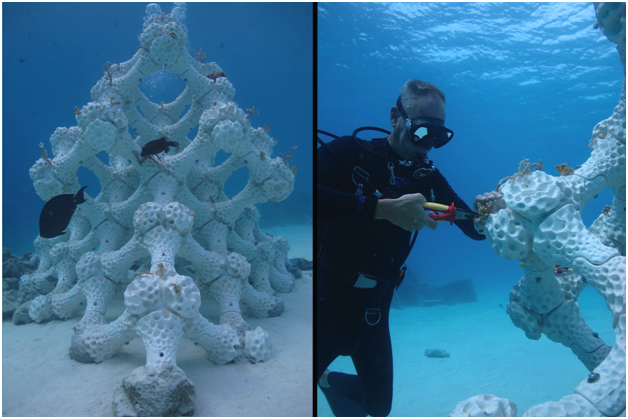Preliminary Research and Documentation
WIP - do not edit
The following research and documentation is meant to get this project started. Please consider this a work in progress. Significant work is needed to move this project forward.
RequirementsAlgae as a Food Source
StructureSpirulina
Spirulina is a microalgae that grows in both fresh and
Material-saltNaturalwater.coralsOftenarereferredmadeto as blue-green algae, It is a family ofcalciumsingle-celledcarbonate (limestone). We need to investigate if we can print using calcium carbonate and other materialsalgae that areare sturdyphotosynthetic andeco-friendly.canThegrowstructureinmustfreshbewatersturdyasenoughwell as salt water.It is one of the most popular food supplements and taste enhancers used by chefs all around the world. It comes packed with nutrition resulting a number of health benefits.
Spirulina is super rich in proteins - about 60% to
withstand70%underwaterofcurrentsspirulina is made up to proteins. In addition, it is rich in minerals like Calcium, Iron, Magnesium, Potassium, Sodium, Phosphorus, Copper, Manganese, Zinc, Cobalt, Sulfur andimpactChromium.bySpirulina
bigisfish.aThegoodcoloringsourcemustforlookvitaminsnatural.like Insideβ-carotenethe(Pro-vitaminstructureA), Vitamin B1, Vitamin B2, Vitamin B6, Vitamin E, Vitamin K, Niacin, Pantothenic acid, Biotin, and Folic acid.-TheIts
structureotherneedsingredientstoincludehavedietarychambersfibers,orpolysaccharides,crevicesLinoleic acid, Zeaxanthin, Chlorophyll a, and Nucleic acids thatfish can use to hide from predators. Or make it their home. Fish love that. When designing the structure, we need to ensure that there is enough natural lightinghelp in thecrevices.generalAlsowellwebeingneedoftohumans.investigateif we can add artificial lightingCultivating and
maybeProcessingevenSpirulinaCultivating and harvesting spirulina is a
camerasimpletoprocess. Thestudy polypsprocess andothercultivationmarineoflife.Spirulina Rootingistheavailablestructure- Natural corals tend to grow roots and grow into the in the ocean bed. The 3D printed coral must have a rooting structure that can be drilled into the ocean floor. This will make the overall structure sturdy enough to withstand under water currents and impact by big fish.
Macroalgae
Bladder Wrack
Dulce
Irish Moss
Kombu
Nori
Sea Grapes
Sea Lettuce
Wakame
Cultivating Algae
Harvesting Algae
Storing Algae
Algae Recipes
Figure 3 - Coral reef installation
References
In 1997 the first Saya de Malha expedition was conducted by Wolf Hilbertz, Thomas Goreau, Kai Hilbertz and Caroline Mekie. Due to the distance and cost of getting there, only 1.5 days could be spent on site on the North Bank. Several dives were conducted, about 1.5 hours of underwater video was taken documenting the fauna and flora, and a small Biorock™ coral nursery was constructed, powered by a single floating solar panel. The area was found to be dominated by seagrasses, but small coral reefs were found with a very high diversity of coral and fish species.
Surprisingly these reefs were not dominated by any one group of corals, as is typical of most Indian Ocean reefs. Instead the coral populations consisted of small numbers of many different groups of corals, widely distributed. The larger corals were mostly rounded heads of Porites, or clumps of columnar Heliopora or Millepora, with smaller corals of many kinds around them. Many corals were observed to be loosely attached to the bottom, and many were being attacked by boring sponges, by several distinct coral diseases, or had algae overgrowing their edges.
Detailed information is available in the Saya de Malha Expedition (2002) report.
Also See
Dr. David Vaughan at the Mote Laboratory is growing coral 40 times faster than in the wild. The lab takes a coral that is about as big as a golf ball and cut it into 20 to 100 micro-fragments. Each fragment grows back in a few months. Detailed information and links are available in the Micro-Fragmenting report.
Related Projects
Marine Restoration - Coral Reefs
Licensing
This project is being developed as an open-source project with the following licensing:
- Software: GPL-3.0 - https://www.gnu.org/licenses/gpl-3.0.en.html
- Hardware, Design & other Intellectual Property: CC-BY-SA-4.0 - https://creativecommons.org/licenses/by-sa/4.0/

